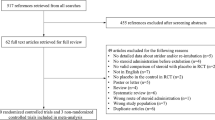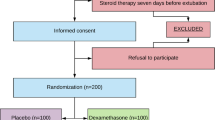Abstract
Background and Objectives
Sore throat, cough, and hoarseness are the common and severe complications after general anesthesia with tracheal intubation. The efficacy of prophylactic administration of corticosteroids in reducing the incidence of postoperative complications is controversial. Thus, we conducted a meta-analysis to assess the effects of corticosteroids in the prevention of postoperative complications.
Methods
A comprehensive literature search of Pubmed, Embase, and Web of Science was conducted to identify relative trials. Eligible studies were randomized controlled trials (RCTs) that assessed the effect of corticosteroids for preventing postoperative complications. The outcomes included the prevalence of postoperative sore throat, cough, hoarseness, laryngeal edema, and reintubation. A random-effects or fixed-effects model was used to pool the estimates, according to the heterogeneity among the included studies.
Results
Eighteen RCTs with a total of 2685 patients were included in this meta-analysis. Pooled estimates showed that corticosteroids significantly reduced the incidence of postoperative sore throat, hoarseness, and cough. Moreover, corticosteroids had a positive effect on the incidence of laryngeal edema and reintubation. Subgroup analysis showed that corticosteroids significantly decreased the incidence of severe sore throat and hoarseness, but not cough.
Conclusion
Evidence from this meta-analysis of 18 RCTs indicated that prophylactic administration of corticosteroids is not only effective in reducing the incidence and severity of postoperative sore throat and hoarseness, but also the incidence of laryngeal edema and reintubation.





Similar content being viewed by others
References
Stauffer JL, Olson DE, Petty TL. Complications and consequences of endotracheal intubation and tracheotomy. A prospective study of 150 critically ill adult patients. Am J Med. 1981;70(1):65–76.
Kastanos N, Estopa Miro R, Marin Perez A, Xaubet Mir A, Agusti Vidal A. Laryngotracheal injury due to endotracheal intubation: incidence, evolution, and predisposing factors. A prospective long-term study. Crit Care Med. 1983;11(5):362–7.
McHardy FE, Chung F. Postoperative sore throat: cause, prevention and treatment. Anaesthesia. 1999;54(5):444–53.
Jones MW, Catling S, Evans E, Green DH, Green JR. Hoarseness after tracheal intubation. Anaesthesia. 1992;47(3):213–6.
Oczenski W, Krenn H, Dahaba AA, Binder M, El-Schahawi-Kienzl I, Kohout S, et al. Complications following the use of the Combitube, tracheal tube and laryngeal mask airway. Anaesthesia. 1999;54(12):1161–5.
Christensen AM, Willemoes-Larsen H, Lundby L, Jakobsen KB. Postoperative throat complaints after tracheal intubation. Br J Anaesthesia. 1994;73(6):786–7.
Higgins PP, Chung F, Mezei G. Postoperative sore throat after ambulatory surgery. Br J Anaesthesia. 2002;88(4):582–4.
Macario A, Weinger M, Carney S, Kim A. Which clinical anesthesia outcomes are important to avoid? The perspective of patients. Anesthesia Analgesia. 1999;89(3):652–8.
Biro P, Seifert B, Pasch T. Complaints of sore throat after tracheal intubation: a prospective evaluation. Eur J Anaesthesiol. 2005;22(4):307–11.
Porter NE, Sidou V, Husson J. Postoperative sore throat: incidence and severity after the use of lidocaine, saline, or air to inflate the endotracheal tube cuff. AANA J. 1999;67(1):49–52.
Stout DM, Bishop MJ, Dwersteg JF, Cullen BF. Correlation of endotracheal tube size with sore throat and hoarseness following general anesthesia. Anesthesiology. 1987;67(3):419–21.
Stenqvist O, Nilsson K. Postoperative sore throat related to tracheal tube cuff design. Can Anaesthetists Soc J. 1982;29(4):384–6.
Estebe JP, Delahaye S, Le Corre P, Dollo G, Le Naoures A, Chevanne F, et al. Alkalinization of intra-cuff lidocaine and use of gel lubrication protect against tracheal tube-induced emergence phenomena. Br J Anaesthesia. 2004;92(3):361–6. doi:10.1093/bja/aeh078.
Estebe JP, Dollo G, Le Corre P, Le Naoures A, Chevanne F, Le Verge R, et al. Alkalinization of intracuff lidocaine improves endotracheal tube-induced emergence phenomena. Anesthesia Analgesia. 2002;94(1):227–30.
Wei JL, Kasperbauer JL, Weaver AL, Boggust AJ. Efficacy of single-dose dexamethasone as adjuvant therapy for acute pharyngitis. Laryngoscope. 2002;112(1):87–93. doi:10.1097/00005537-200201000-00016.
Way WL, Sooy FA. Histologic changes produced by endotracheal intubation. Ann Otol Rhinol Laryngol. 1965;74(3):799–812.
Ruangsin S, Wanasuwannakul T, Pattaravit N, Asim W. Effectiveness of a preoperative single dose intravenous dexamethasone in reducing the prevalence of postoperative sore throat after endotracheal intubation. J Med Assoc Thailand (Chotmaihet thangphaet). 2012;95(5):657–60.
Cheng KC, Hou CC, Huang HC, Lin SC, Zhang H. Intravenous injection of methylprednisolone reduces the incidence of postextubation stridor in intensive care unit patients. Crit Care Med. 2006;34(5):1345–50. doi:10.1097/01.ccm.0000214678.92134.bd.
Ayoub CM, Ghobashy A, Koch ME, McGrimley L, Pascale V, Qadir S, et al. Widespread application of topical steroids to decrease sore throat, hoarseness, and cough after tracheal intubation. Anesthesia Analgesia. 1998;87(3):714–6.
Moher D, Liberati A, Tetzlaff J, Altman DG. Preferred reporting items for systematic reviews and meta-analyses: the PRISMA statement. BMJ (Clin Res ed). 2009;339:b2535. doi:10.1136/bmj.b2535.
Jadad AR, Moore RA, Carroll D, Jenkinson C, Reynolds DJ, Gavaghan DJ, et al. Assessing the quality of reports of randomized clinical trials: is blinding necessary? Controlled Clin Trials. 1996;17(1):1–12.
Kjaergard LL, Villumsen J, Gluud C. Reported methodologic quality and discrepancies between large and small randomized trials in meta-analyses. Ann Intern Med. 2001;135(11):982–9.
Higgins JP, Thompson SG, Deeks JJ, Altman DG. Measuring inconsistency in meta-analyses. BMJ. 2003;327(7414):557–60. doi:10.1136/bmj.327.7414.557.
DerSimonian R, Laird N. Meta-analysis in clinical trials. Control Clin Trials. 1986;7(3):177–88.
Mantel N, Haenszel W. Statistical aspects of the analysis of data from retrospective studies of disease. J Nat Cancer Inst. 1959;22(4):719–48.
Begg CB, Mazumdar M. Operating characteristics of a rank correlation test for publication bias. Biometrics. 1994;50(4):1088–101.
Egger M, Davey Smith G, Schneider M, Minder C. Bias in meta-analysis detected by a simple, graphical test. BMJ (Clin Res ed). 1997;315(7109):629–34.
Tazeh-Kand NF, Eslami B, Mohammadian K. Inhaled fluticasone propionate reduces postoperative sore throat, cough, and hoarseness. Anesthesia Analgesia. 2010;111(4):895–8. doi:10.1213/ANE.0b013e3181c8a5a2.
Lee CH, Peng MJ, Wu CL. Dexamethasone to prevent postextubation airway obstruction in adults: a prospective, randomized, double-blind, placebo-controlled study. Crit Care (London, England). 2007;11(4):R72. doi:10.1186/cc5957.
Park SH, Han SH, Do SH, Kim JW, Rhee KY, Kim JH. Prophylactic dexamethasone decreases the incidence of sore throat and hoarseness after tracheal extubation with a double-lumen endobronchial tube. Anesthesia Analgesia. 2008;107(6):1814–8. doi:10.1213/ane.0b013e318185d093.
Francois B, Bellissant E, Gissot V, Desachy A, Normand S, Boulain T, et al. 12-h pretreatment with methylprednisolone versus placebo for prevention of postextubation laryngeal oedema: a randomised double-blind trial. Lancet (London, England). 2007;369(9567):1083–9. doi:10.1016/s0140-6736(07)60526-1.
Narasethakamol A, Techanivate A, Saothongthong J, Yurakate N, Cousnit P. Application of mometasone spray to reduce sore throat after tracheal intubation. J Med Assoc Thailand (Chotmaihet thangphaet). 2011;94(8):958–64.
Thomas S, Beevi S. Dexamethasone reduces the severity of postoperative sore throat. Can J Anaesthia (J Can d’Anesthesie). 2007;54(11):897–901. doi:10.1007/bf03026793.
Park SY, Kim SH, Lee SJ, Chae WS, Jin HC, Lee JS, et al. Application of triamcinolone acetonide paste to the endotracheal tube reduces postoperative sore throat: a randomized controlled trial. Can J Anaesthia (J Can d’Anesthesie). 2011;58(5):436–42. doi:10.1007/s12630-011-9478-6.
De Oliveira GS, Ahmad S, Fitzgerald PC, Marcus RJ, Altman CS, Panjwani AS, et al. Dose ranging study on the effect of preoperative dexamethasone on postoperative quality of recovery and opioid consumption after ambulatory gynaecological surgery. Br J Anaesthesia. 2011;107(3):362–71. doi:10.1093/bja/aer156.
Kazemi A, Amini A. The effect of betamethasone gel in reducing sore throat, cough, and hoarseness after laryngo-tracheal intubation. Middle East J Anaesthesiol. 2007;19(1):197–204.
Bagchi D, Mandal MC, Das S, Sahoo T, Basu SR, Sarkar S. Efficacy of intravenous dexamethasone to reduce incidence of postoperative sore throat: A prospective randomized controlled trial. J Anaesthesiol Clin Pharmacol. 2012;28(4):477–80. doi:10.4103/0970-9185.101920.
Eydi M, Kolahdouzan K, Golzari SE. Effect of intravenous hydrocortisone on preventing postoperative sore throat followed by laryngeal mask airway use in patients undergoing urogenital surgeries. J Cardiovasc Thor Res. 2013;5(1):29–33. doi:10.5681/jcvtr.2013.006.
Cheng KC, Chen CM, Tan CK, Chen HM, Lu CL, Zhang H. Methylprednisolone reduces the rates of postextubation stridor and reintubation associated with attenuated cytokine responses in critically ill patients. Minerva Anestesiologica. 2011;77(5):503–9.
Darmon JY, Rauss A, Dreyfuss D, Bleichner G, Elkharrat D, Schlemmer B, et al. Evaluation of risk factors for laryngeal edema after tracheal extubation in adults and its prevention by dexamethasone. A placebo-controlled, double-blind, multicenter study. Anesthesiology. 1992;77(2):245–51.
Ho LI, Harn HJ, Lien TC, Hu PY, Wang JH. Postextubation laryngeal edema in adults. Risk factor evaluation and prevention by hydrocortisone. Intens Care Med. 1996;22(9):933–6.
Gaussorgues P, Boyer F, Piperno D, Gerard M, Leger P, Robert D. Do corticosteroids prevent postextubation laryngeal edema? Prospective study of 276 adults. Crit Care Med. 1988;16(6):649.
Donnelly WH. Histopathology of endotracheal intubation. An autopsy study of 99 cases. Arch Pathol. 1969;88(5):511–20.
Colice GL, Stukel TA, Dain B. Laryngeal complications of prolonged intubation. Chest. 1989;96(4):877–84.
Ferrara TB, Georgieff MK, Ebert J, Fisher JB. Routine use of dexamethasone for the prevention of postextubation respiratory distress. J Perinatol. 1989;9(3):287–90.
Tellez DW, Galvis AG, Storgion SA, Amer HN, Hoseyni M, Deakers TW. Dexamethasone in the prevention of postextubation stridor in children. J Pediatr. 1991;118(2):289–94.
Parfitt K, Martindale W. The complete drug reference, 32nd edn. 1999. p. 1046.
Author information
Authors and Affiliations
Corresponding author
Ethics declarations
Conflicts of interest
Wenyu Zhang, Guoqing Zhao, Longyun Li, and Pengcheng Zhao declare that they have no conflicts of interest.
Rights and permissions
About this article
Cite this article
Zhang, W., Zhao, G., Li, L. et al. Prophylactic Administration of Corticosteroids for Preventing Postoperative Complications Related to Tracheal Intubation: A Systematic Review and Meta-Analysis of 18 Randomized Controlled Trials. Clin Drug Investig 36, 255–265 (2016). https://doi.org/10.1007/s40261-015-0369-4
Published:
Issue Date:
DOI: https://doi.org/10.1007/s40261-015-0369-4




